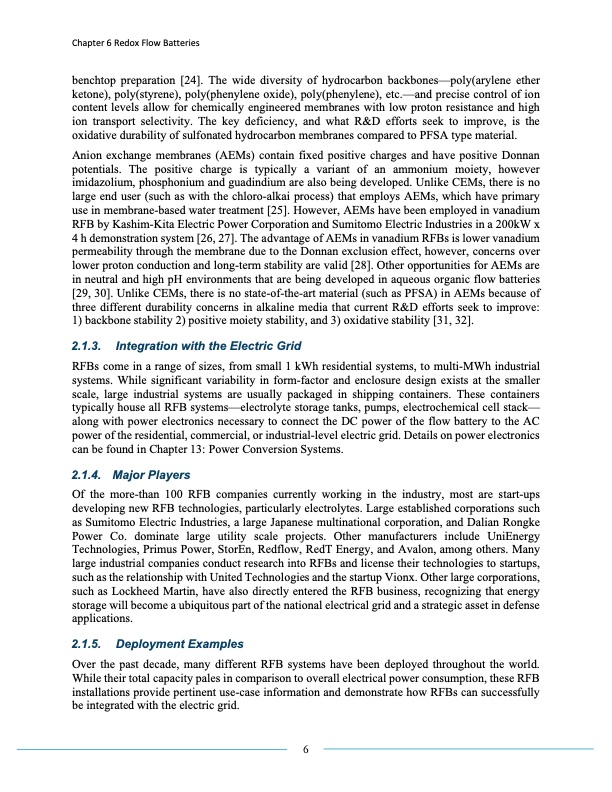
PDF Publication Title:
Text from PDF Page: 006
Chapter 6 Redox Flow Batteries benchtop preparation [24]. The wide diversity of hydrocarbon backbones—poly(arylene ether ketone), poly(styrene), poly(phenylene oxide), poly(phenylene), etc.—and precise control of ion content levels allow for chemically engineered membranes with low proton resistance and high ion transport selectivity. The key deficiency, and what R&D efforts seek to improve, is the oxidative durability of sulfonated hydrocarbon membranes compared to PFSA type material. Anion exchange membranes (AEMs) contain fixed positive charges and have positive Donnan potentials. The positive charge is typically a variant of an ammonium moiety, however imidazolium, phosphonium and guadindium are also being developed. Unlike CEMs, there is no large end user (such as with the chloro-alkai process) that employs AEMs, which have primary use in membrane-based water treatment [25]. However, AEMs have been employed in vanadium RFB by Kashim-Kita Electric Power Corporation and Sumitomo Electric Industries in a 200kW x 4 h demonstration system [26, 27]. The advantage of AEMs in vanadium RFBs is lower vanadium permeability through the membrane due to the Donnan exclusion effect, however, concerns over lower proton conduction and long-term stability are valid [28]. Other opportunities for AEMs are in neutral and high pH environments that are being developed in aqueous organic flow batteries [29, 30]. Unlike CEMs, there is no state-of-the-art material (such as PFSA) in AEMs because of three different durability concerns in alkaline media that current R&D efforts seek to improve: 1) backbone stability 2) positive moiety stability, and 3) oxidative stability [31, 32]. 2.1.3. Integration with the Electric Grid RFBs come in a range of sizes, from small 1 kWh residential systems, to multi-MWh industrial systems. While significant variability in form-factor and enclosure design exists at the smaller scale, large industrial systems are usually packaged in shipping containers. These containers typically house all RFB systems—electrolyte storage tanks, pumps, electrochemical cell stack— along with power electronics necessary to connect the DC power of the flow battery to the AC power of the residential, commercial, or industrial-level electric grid. Details on power electronics can be found in Chapter 13: Power Conversion Systems. 2.1.4. Major Players Of the more-than 100 RFB companies currently working in the industry, most are start-ups developing new RFB technologies, particularly electrolytes. Large established corporations such as Sumitomo Electric Industries, a large Japanese multinational corporation, and Dalian Rongke Power Co. dominate large utility scale projects. Other manufacturers include UniEnergy Technologies, Primus Power, StorEn, Redflow, RedT Energy, and Avalon, among others. Many large industrial companies conduct research into RFBs and license their technologies to startups, such as the relationship with United Technologies and the startup Vionx. Other large corporations, such as Lockheed Martin, have also directly entered the RFB business, recognizing that energy storage will become a ubiquitous part of the national electrical grid and a strategic asset in defense applications. 2.1.5. Deployment Examples Over the past decade, many different RFB systems have been deployed throughout the world. While their total capacity pales in comparison to overall electrical power consumption, these RFB installations provide pertinent use-case information and demonstrate how RFBs can successfully be integrated with the electric grid. 6PDF Image | REDOX FLOW BATTERIES Chapter 6

PDF Search Title:
REDOX FLOW BATTERIES Chapter 6Original File Name Searched:
ESHB_Ch6_RedoxFlow_Small.pdfDIY PDF Search: Google It | Yahoo | Bing
Salgenx Redox Flow Battery Technology: Salt water flow battery technology with low cost and great energy density that can be used for power storage and thermal storage. Let us de-risk your production using our license. Our aqueous flow battery is less cost than Tesla Megapack and available faster. Redox flow battery. No membrane needed like with Vanadium, or Bromine. Salgenx flow battery
| CONTACT TEL: 608-238-6001 Email: greg@salgenx.com | RSS | AMP |